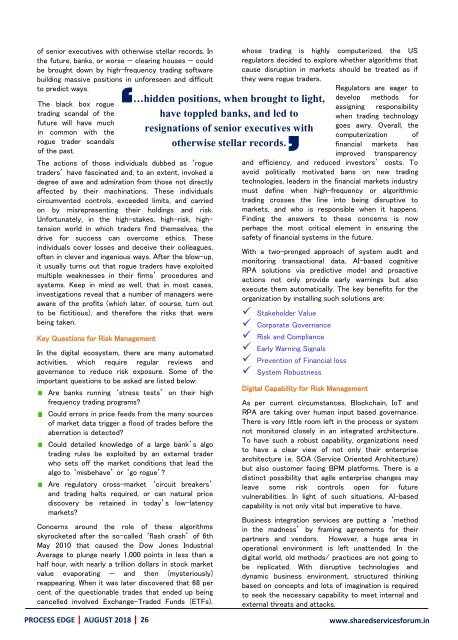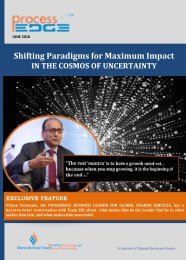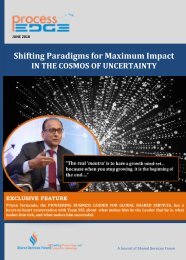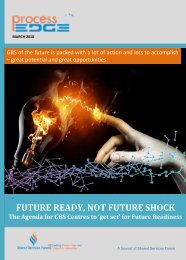SSF's Journal - Aug'18
You also want an ePaper? Increase the reach of your titles
YUMPU automatically turns print PDFs into web optimized ePapers that Google loves.
of senior executives with otherwise stellar records. In<br />
the future, banks, or worse — clearing houses — could<br />
be brought down by high-frequency trading software<br />
building massive positions in unforeseen and difficult<br />
to predict ways.<br />
‘<br />
The black box rogue<br />
trading scandal of the<br />
future will have much<br />
in common with the<br />
rogue trader scandals<br />
of the past.<br />
The actions of those individuals dubbed as ‘rogue<br />
traders’ have fascinated and, to an extent, invoked a<br />
degree of awe and admiration from those not directly<br />
affected by their machinations. These individuals<br />
circumvented controls, exceeded limits, and carried<br />
on by misrepresenting their holdings and risk.<br />
Unfortunately, in the high-stakes, high-risk, hightension<br />
world in which traders find themselves, the<br />
drive for success can overcome ethics. These<br />
individuals cover losses and deceive their colleagues,<br />
often in clever and ingenious ways. After the blow-up,<br />
it usually turns out that rogue traders have exploited<br />
multiple weaknesses in their firms’ procedures and<br />
systems. Keep in mind as well, that in most cases,<br />
investigations reveal that a number of managers were<br />
aware of the profits (which later, of course, turn out<br />
to be fictitious), and therefore the risks that were<br />
being taken.<br />
Key Questions for Risk Management<br />
In the digital ecosystem, there are many automated<br />
activities, which require regular reviews and<br />
governance to reduce risk exposure. Some of the<br />
important questions to be asked are listed below:<br />
Are banks running ‘stress tests’ on their high<br />
frequency trading programs?<br />
Could errors in price feeds from the many sources<br />
of market data trigger a flood of trades before the<br />
aberration is detected?<br />
Could detailed knowledge of a large bank’s algo<br />
trading rules be exploited by an external trader<br />
who sets off the market conditions that lead the<br />
algo to ‘misbehave’ or ‘go rogue’?<br />
Are regulatory cross-market ‘circuit breakers’<br />
and trading halts required, or can natural price<br />
discovery be retained in today’s low-latency<br />
markets?<br />
Concerns around the role of these algorithms<br />
skyrocketed after the so-called ‘flash crash’ of 6th<br />
May 2010 that caused the Dow Jones Industrial<br />
Average to plunge nearly 1,000 points in less than a<br />
half hour, with nearly a trillion dollars in stock market<br />
value evaporating — and then (mysteriously)<br />
reappearing. When it was later discovered that 68 per<br />
cent of the questionable trades that ended up being<br />
cancelled involved Exchange-Traded Funds (ETFs),<br />
PROCESS EDGE | AUGUST 20<strong>18</strong> |<br />
…hidden positions, when brought to light,<br />
have toppled banks, and led to<br />
resignations of senior executives with<br />
otherwise stellar records.<br />
26<br />
whose trading is highly computerized, the US<br />
regulators decided to explore whether algorithms that<br />
cause disruption in markets should be treated as if<br />
they were rogue traders.<br />
Regulators are eager to<br />
develop methods for<br />
assigning responsibility<br />
when trading technology<br />
goes awry. Overall, the<br />
’<br />
computerization of<br />
financial markets has<br />
improved transparency<br />
and efficiency, and reduced investors’ costs. To<br />
avoid politically motivated bans on new trading<br />
technologies, leaders in the financial markets industry<br />
must define when high-frequency or algorithmic<br />
trading crosses the line into being disruptive to<br />
markets, and who is responsible when it happens.<br />
Finding the answers to these concerns is now<br />
perhaps the most critical element in ensuring the<br />
safety of financial systems in the future.<br />
With a two-pronged approach of system audit and<br />
monitoring transactional data, AI-based cognitive<br />
RPA solutions via predictive model and proactive<br />
actions not only provide early warnings but also<br />
execute them automatically. The key benefits for the<br />
organization by installing such solutions are:<br />
Stakeholder Value<br />
Corporate Governance<br />
Risk and Compliance<br />
Early Warning Signals<br />
Prevention of Financial loss<br />
System Robustness<br />
Digital Capability for Risk Management<br />
As per current circumstances, Blockchain, IoT and<br />
RPA are taking over human input based governance.<br />
There is very little room left in the process or system<br />
not monitored closely in an integrated architecture.<br />
To have such a robust capability, organizations need<br />
to have a clear view of not only their enterprise<br />
architecture i.e. SOA (Service Oriented Architecture)<br />
but also customer facing BPM platforms. There is a<br />
distinct possibility that agile enterprise changes may<br />
leave some risk controls open for future<br />
vulnerabilities. In light of such situations, AI-based<br />
capability is not only vital but imperative to have.<br />
Business integration services are putting a ‘method<br />
in the madness’ by framing agreements for their<br />
partners and vendors. However, a huge area in<br />
operational environment is left unattended. In the<br />
digital world, old methods/ practices are not going to<br />
be replicated. With disruptive technologies and<br />
dynamic business environment, structured thinking<br />
based on concepts and lots of imagination is required<br />
to seek the necessary capability to meet internal and<br />
external threats and attacks.<br />
www.sharedservicesforum.in





